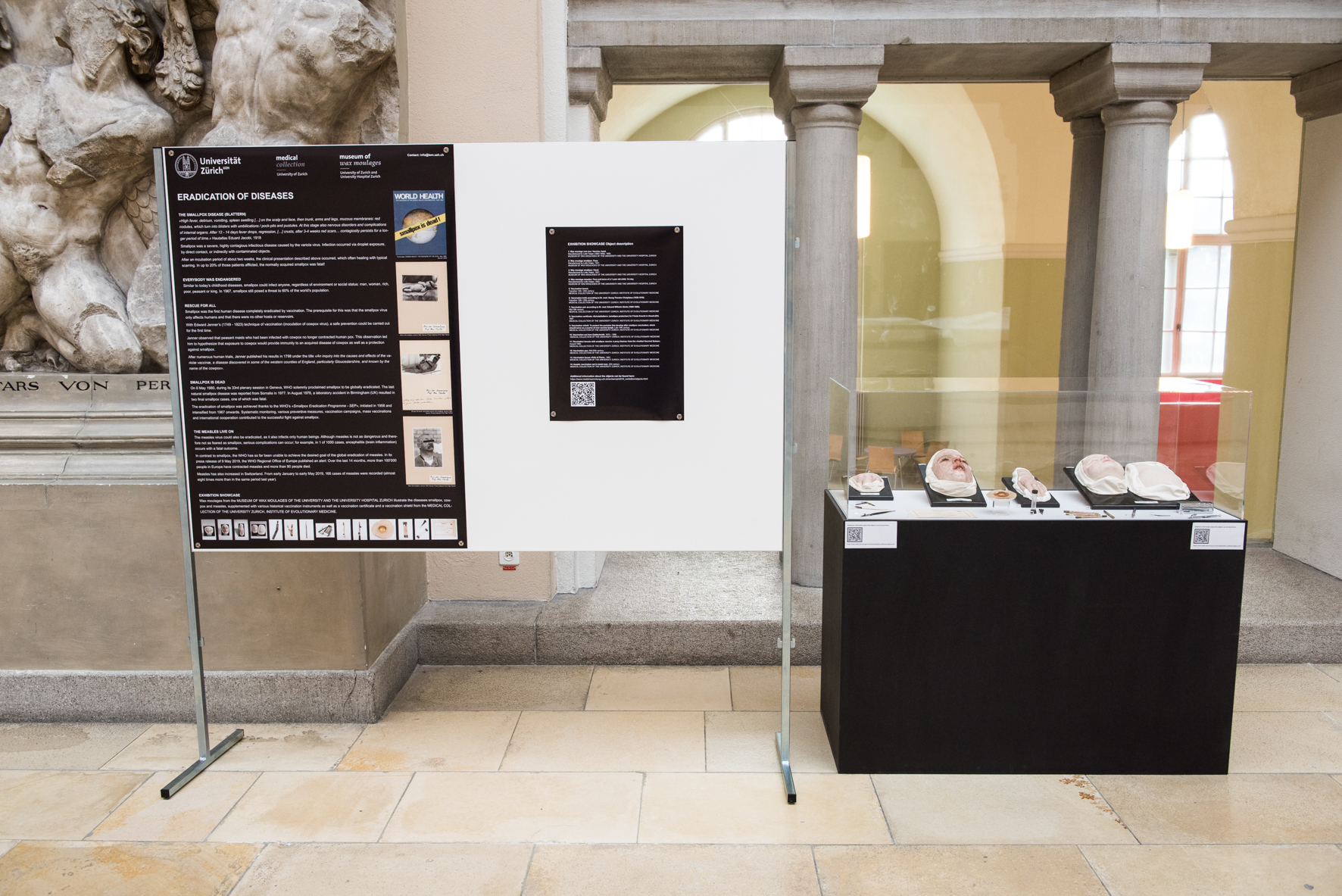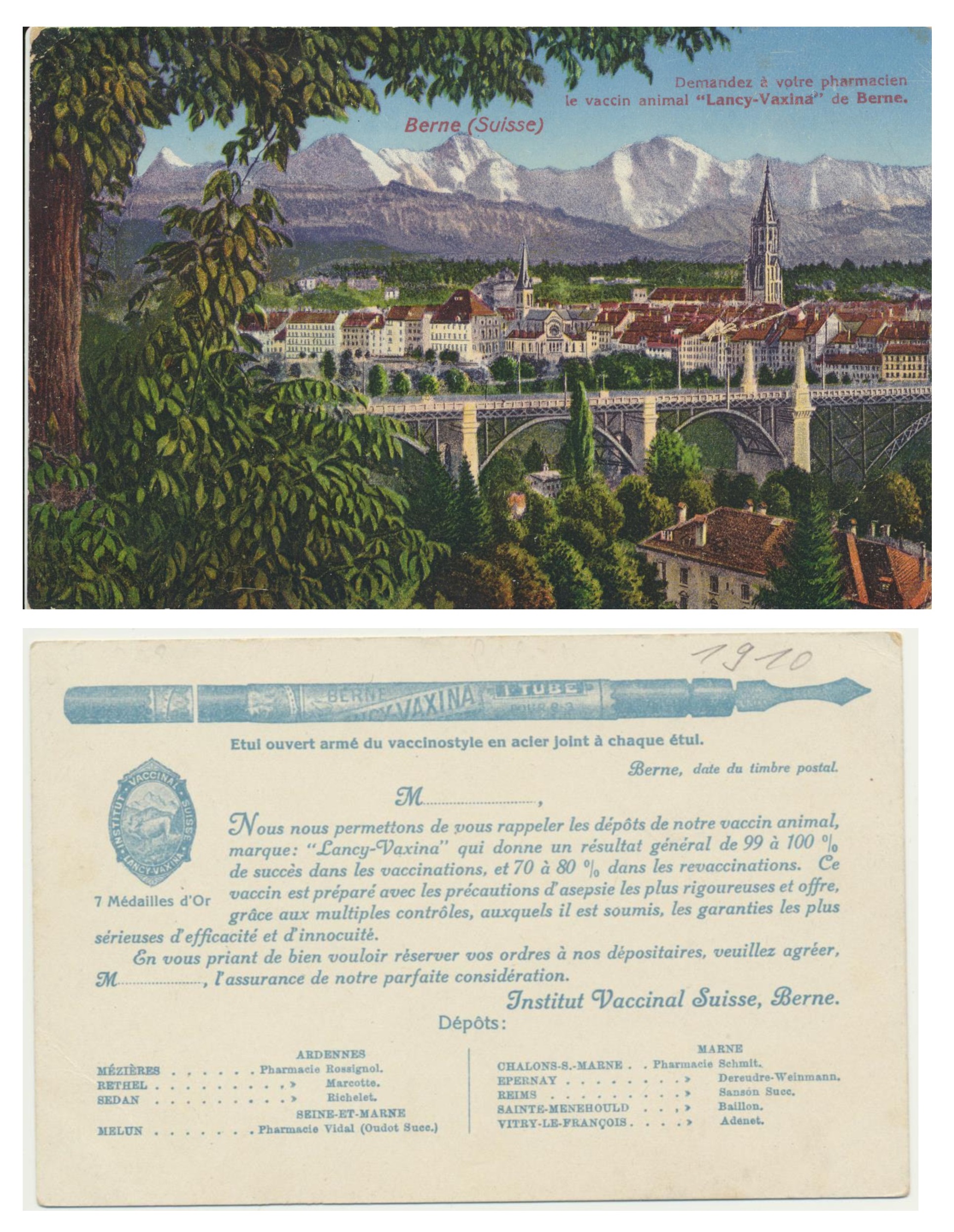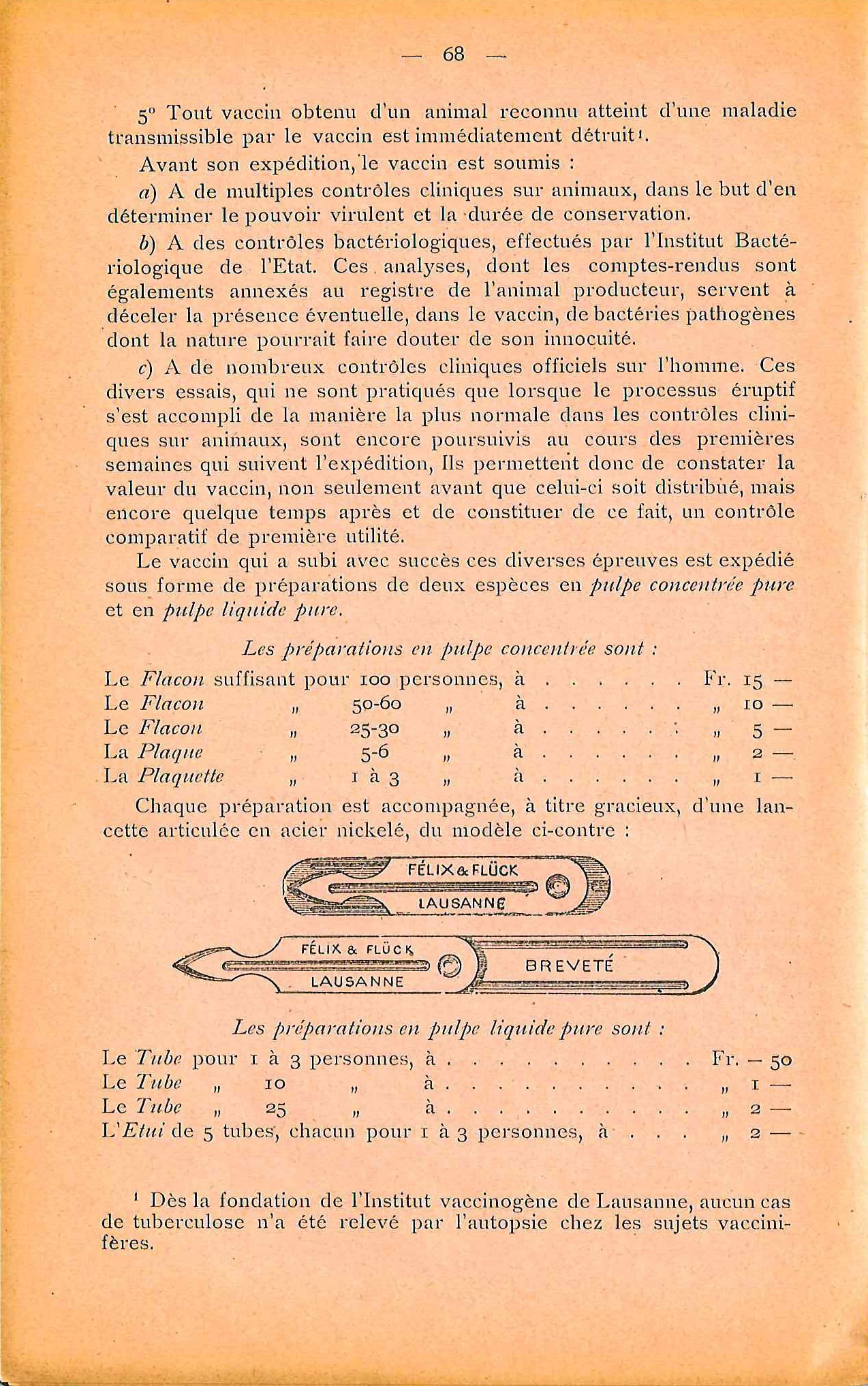ISEMPH Exhibition
The Fifth Annual Meeting of the International Society for Evolution, Medicine, and Public Health took place at the main building of the University of Zurich (August 2019).
The Institute of Evolutionary Medicine (IEM) is the host of this meeting in Zurich.
For this meeting the Medical Collection and the Museum of Wax Moulages created an exhibition consisting of the following components:
- Exhibition showcase with 14 objects (Exhibited between August 13-16 in the atrium, main building of the University of Zurich)
- Exhibition poster (PDF, 1 MB) (Exhibited between August 13-16 in the atrium, main building of the University of Zurich)
- Object description poster (PDF, 108 KB) (Exhibited between August 13-16 in the atrium, main building of the University of Zurich)
Additional information about the objects


Object 1: Wax moulage cow pox: Vaccine, hand
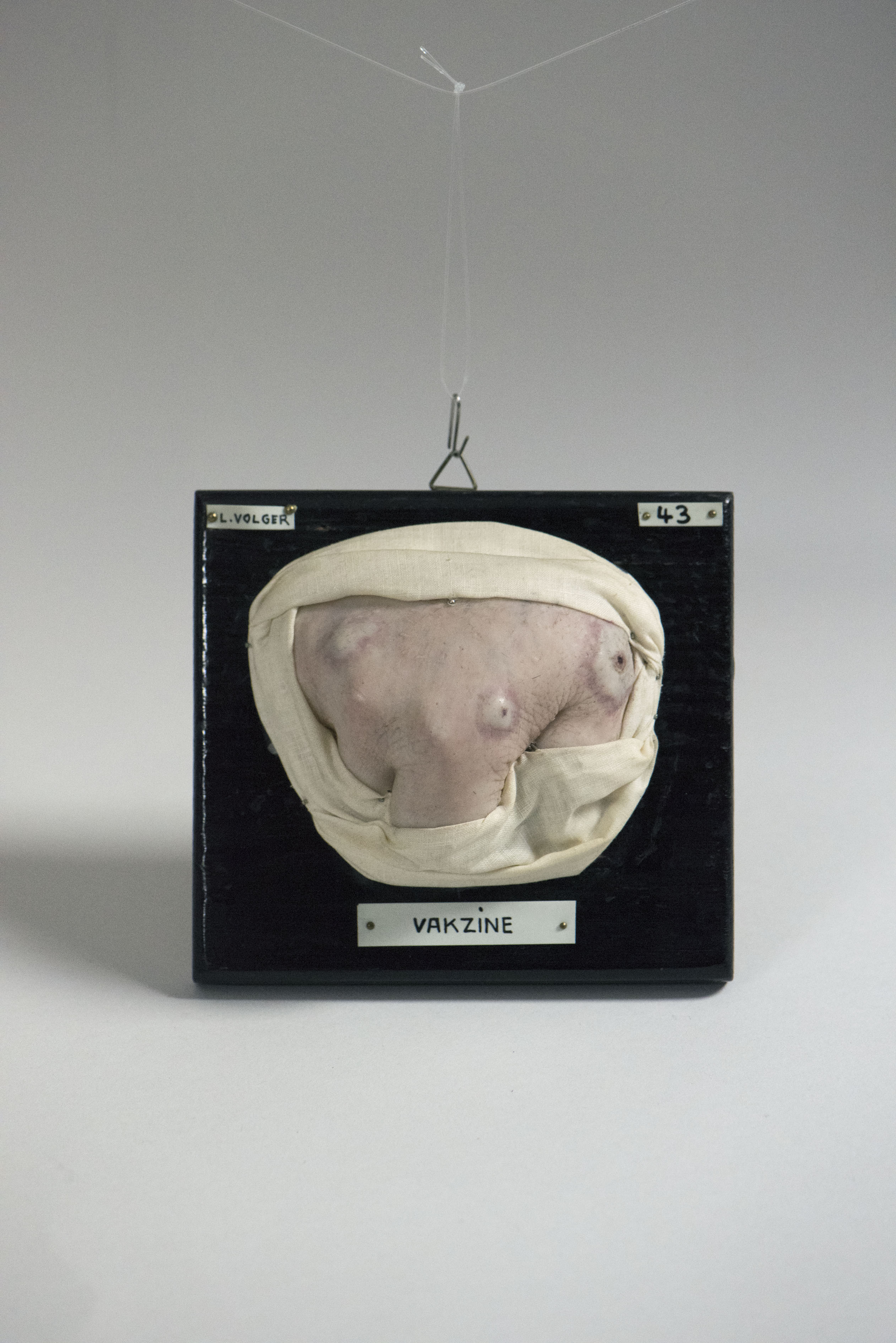
| INVENTORY NUMBER |
43, MUSEUM OF WAX MOULAGES OF THE UNIVERSITY AND THE UNIVERSITY HOSPITAL ZURICH |
| AGE DETERMINATION | 1929 |
| DESCRIPTION | Wax moulage of the back of the hand of the patient Fritz F. who was infected with cow pox. |
| COMMENT |
Wax moulage Nr. 43 shows the hand of Fritz F. with a spreading infection of cow pox. The cow pox virus does not infect humans unless it is applied to a wound, where it usually causes an isolated pustule. The local infection can be spread over the skin by scratching. In patients suffering from eczema damaging the skin barrier or having an immunosuppression, the disease can also spread over the body. Fritz F. might have been intentionally infected receiving a vaccination. But because the patient was not a child, and therefore less likely to receive vaccinations, he could also have been a farmer who was infected directly by a diseased cow during milking. Unfortunately, we are not able to learn more about the patient’s history, because the medical files of the patients illustrated with moulages have been discarded many years ago. |
| MANUFACTURER | Manufacured by Lotte Volger (1883 - 1956) at the Dermatology Clinic of the Kantonsspital Zurich in 1929. |
Object 2: Wax moulage smallpox: Face

| INVENTORY NUMBER |
297, MUSEUM OF WAX MOULAGES OF THE UNIVERSITY AND THE UNIVERSITY HOSPITAL ZURICH |
| AGE DETERMINATION | 1921 |
| DESCRIPTION | Wax moulage of the face of Frieda W. who was infected with small pox during the last epidemic in Zurich in 1921. |
| COMMENT |
In 1921 there was a small epidemic of small pox in Zurich. Lotte Volger was asked to make five moulages of diseased patients, two of them illustrating the disease on the face. Frieda W. was one of these patients. Lotte Volger had to take a negative form with plaster, using small tubes so the patients was able to breath while the plaster was hardening (about 15 minutes). Of course, Frieda W. had her eyes closed. After having poured out the raw moulage with a mixture of bees’ wax, raisin and calcium carbonate, the details like the opened eyes and the nose and mouth had to be shaped. Then the moulage was varnished next to the patient with only four colors (red, blue, brown and yellow). Finally, glass eyes, hair and “pus” (with the help of lacquer) were added and the moulage was mounted on the black wooden board. The moulage illustrates the typical rash, often healing with scars, but also the general illness with inflammation of the conjunctivae, runny nose and general malaise. |
| MANUFACTURER | The moulage has been manufactured by Lotte Volger (1883 - 1956) at the Dermatology Clinic of the Kantonsspital Zurich. |
Object 3: Wax moulage smallpox: Hand
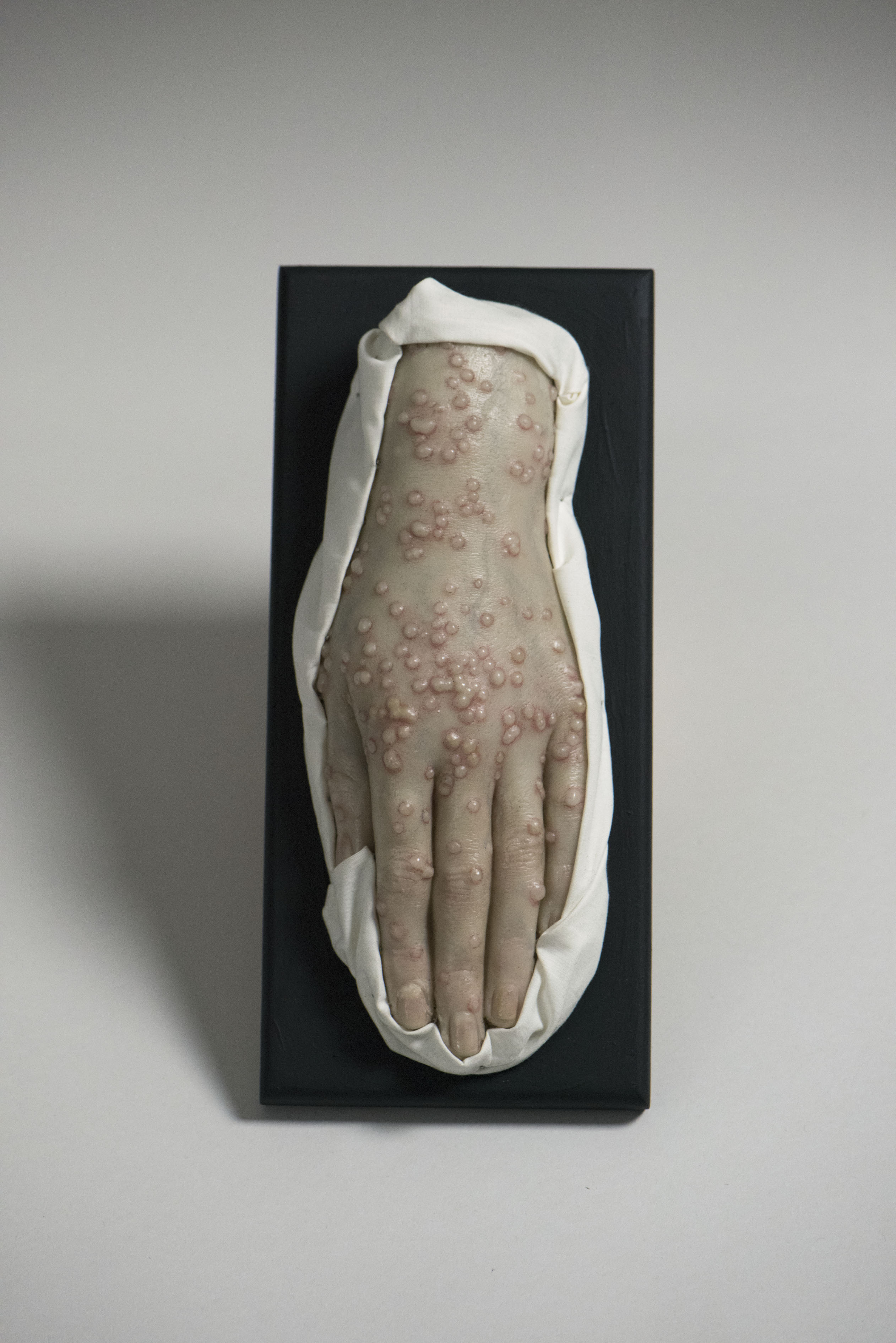
| INVENTORY NUMBER |
298, MUSEUM OF WAX MOULAGES OF THE UNIVERSITY AND THE UNIVERSITY HOSPITAL ZURICH |
| AGE DETERMINATION | 1921 |
| DESCRIPTION | Wax moulage of the hand of a patient who was infected with small pox during the last epidemic in Zurich in 1921. |
| COMMENT | The moulage No 298 shows the typical rash caused by the small pox virus. Red spots turn into papules and then transform into vesicles, pustules and crusty erosions, often healing with scars, contrast to the rash of chickenpox, where papules, vesicles and crusts can occur at the same time, the skin changes of small pox are uniform and alter their appearance all at the same time. |
| MANUFACTURER | The moulage has been manufactured by Lotte Volger (1883 - 1956) at the Dermatology Clinic of the Kantonsspital Zurich. |
Object 4: Wax moulage measles: Face and torso of a 1 year old child, 1st day
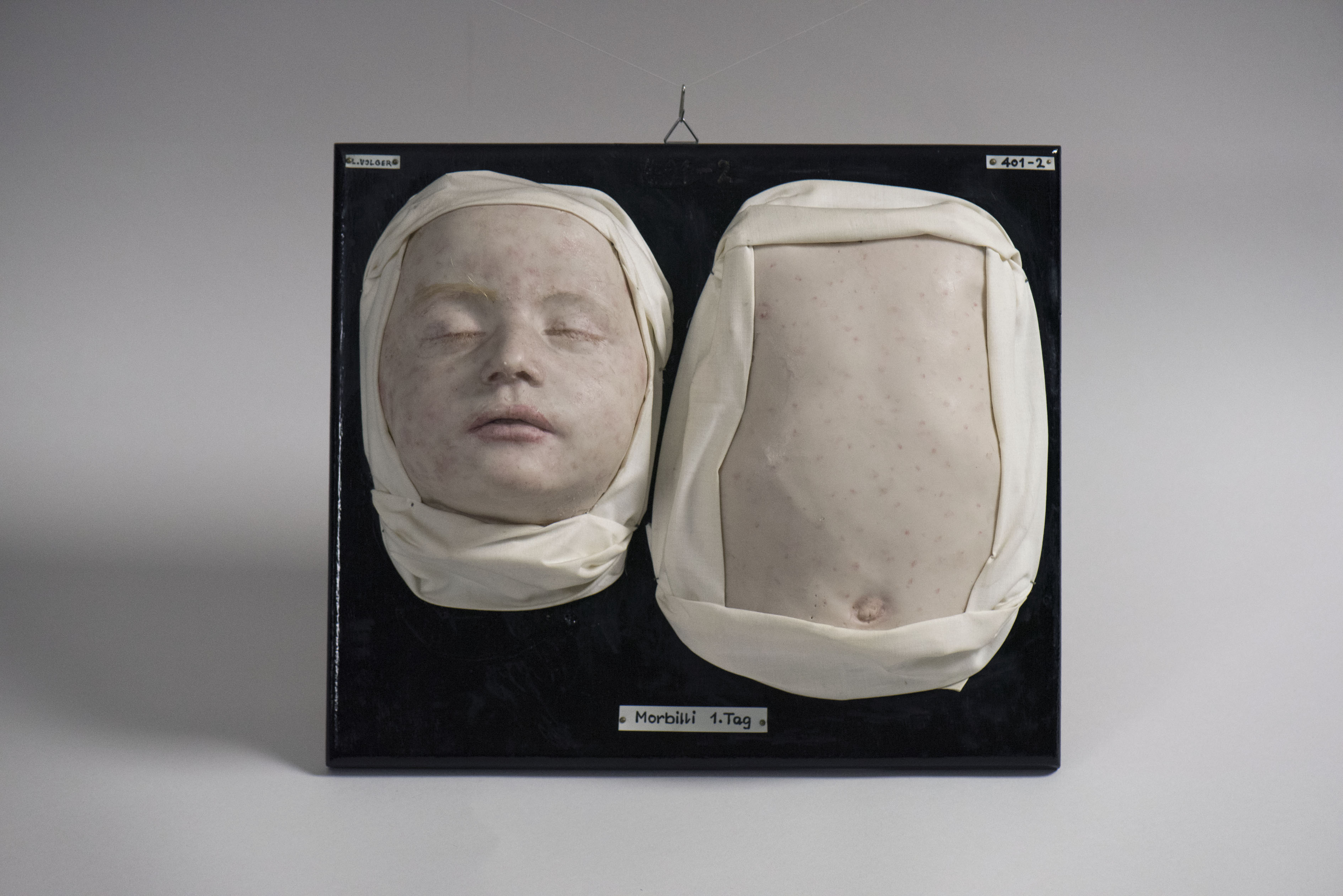
| INVENTORY NUMBER |
401-402, MUSEUM OF WAX MOULAGES OF THE UNIVERSITY AND THE UNIVERSITY HOSPITAL ZURICH |
| AGE DETERMINATION | 1932 |
| DESCRIPTION | Wax moulages of the face and the torso of Esther A. who was infected with measles, showing the first day of the typical rash. |
| COMMENT |
Ten days after the infection with the highly contagious virus the disease starts with malaise, high fever, conjunctivitis and swollen lymph nodes. After two days, white spots appear in the mouth (Koplik-spots) and another two days later, the typical rash begins on the head (retroauricular) and neck, spreading over the torso to the limbs. Complications like bronchopneumonia or otitis media occur in 10 – 15% of the infection (in industrialized countries) and in 1 of 1000 an encephalitis with disabling or fatal outcome can develop. Since 1963 there is an active live vaccine against measles available for children administered at the end of their first year of life with boosters at three and six years of age. |
| MANUFACTURER | Manufactured by Lotte Volger (1883 - 1956) at the Dermatology Clinic at the Kantonsspital Zurich in 1932. |
Object 5: Vaccination lancet
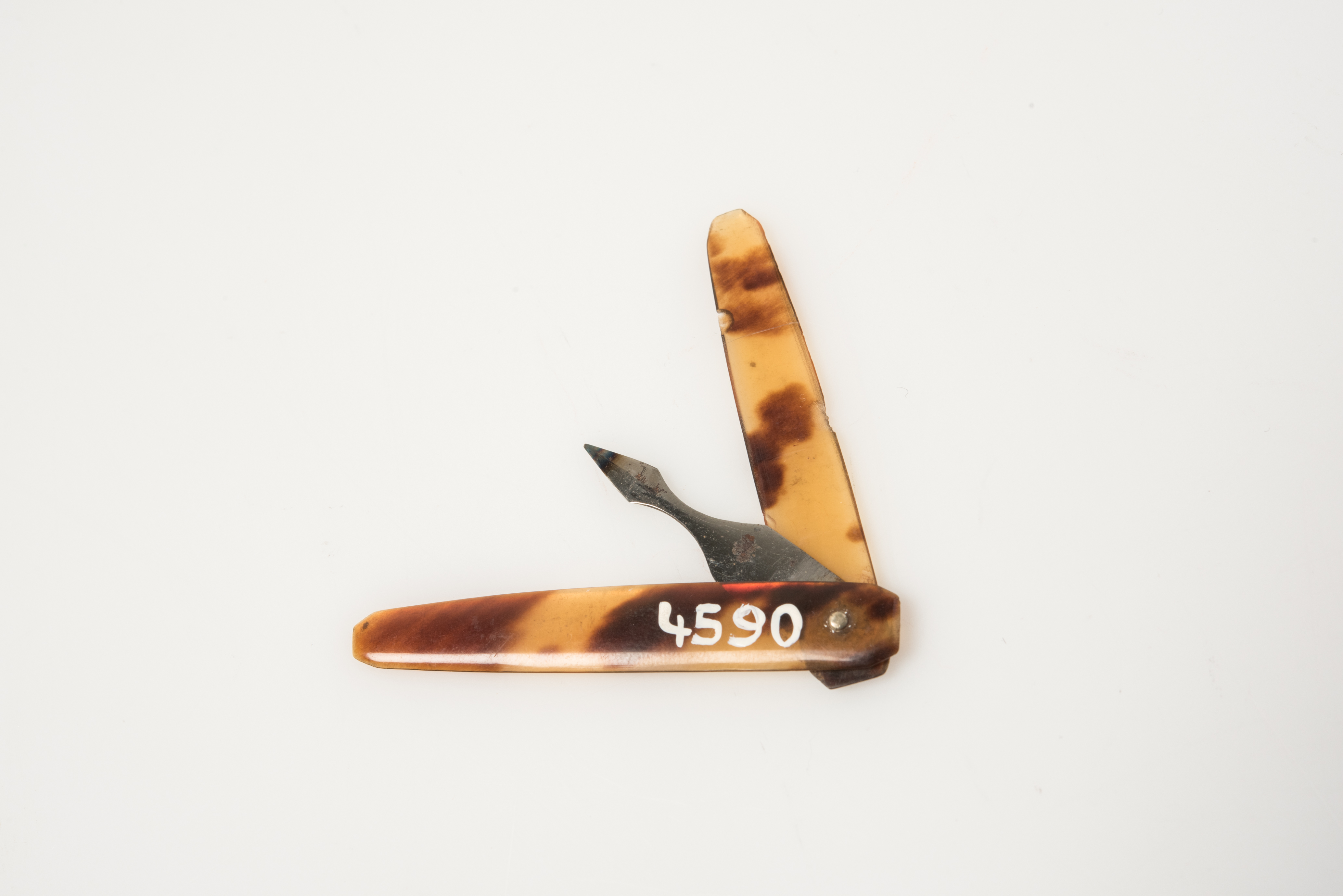
| INVENTORY NUMBER | 4590, MEDICAL COLLECTION OF THE UNIVERSITY ZURICH, INSTITUTE OF EVOLUTIONARY MEDICINE |
| AGE DETERMINATION | Transition 19th / 20th century |
| DESCRIPTION | Short flat handle with double-edged, lance-shaped knife (on one side channel along the blade axis up to the tip), which is attached to the tortoiseshell shells by means of a groove. |
| COMMENT | The channel along the blade axis up to the tip is intended for receiving the liquid lymph. The tip of the blade is discoloured by repeated sterilisation in the flame (Disinfection by flame became popular in the late 19th century). This type of vaccination instrument was in use for a long time; Vaccination lancet to be folded up with shells made of tortoiseshell, horn or hard rubber. Preferred instrument of Henri Marie Husson (1772 - 1853) around 1820, probably invented by him. Became very popular in continental Europe. |
| AUTORSHIP/INVENTOR | Unknown |
| MANUFACTURER | WALTER CARL (SURGICAL INSTRUMENT MAKER FROM BASEL) 1842: First reference to a surgical instrument maker Walter in Basel. 1921/22: Last indication of the company's activity so far. Compare engraving (OBJECT PHOTO 6)
JOHANN JAKOB WALTER-BASLER (1780 - 1856)
CARL WALTER (-KELLER) (1813 - 1872 ?)
CARL EDUARD WALTER-BIONDETTI (1848 - 1921)
|
Object 6: Vaccination knife according to Dr. med. Georg Theodor Chalybäus (1838 - 1919)

| INVENTORY NUMBER | 11431, MEDICAL COLLECTION OF THE UNIVERSITY ZURICH, INSTITUTE OF EVOLUTIONARY MEDICINE |
| AGE DETERMINATION | Transition 19th / 20th century |
| DESCRIPTION | Elongated flat and wide handle made of white, black speckled horn with double edged blunt and lance-shaped knife. |
| COMMENT | Particularly advantageous with this inoculation knife is the easy cleaning, disinfection and handling. In the course of the mass vaccinations, the introduction of the animal lymph and the newly gained knowledge about antisepsis, more solid and easier to handle one-piece vaccination instruments were developed. The long-established foldable vaccination lancets with shells made of tortoiseshell, horn or hard rubber were replaced. The vaccination knife according to Dr. med. Georg Chalybäus is a good example of this development. The switch to calf lymph (around 1880) not only increased the production of vaccine, it also reduced the risk of transmitting human diseases by the vaccine itself. As animal lymph proved less potent than human one, more of it had to be applied on more and longer cuts in the skin. New instruments were developed like this one presented by Dr. Theodor Chalybäus in 1884 in the article |
| AUTORSHIP/INVENTOR | DR. MED. GEORG THEODOR CHALYBÄUS/CHALYBAEUS (1838 - 1919)
SOURCES ABOUT CHALYBÄUS
|
| MANUFACTURER | Unknown |
Object 7: Vaccination pen according to Dr. med. Eduard Wilhelm Güntz (1800 - 1880)
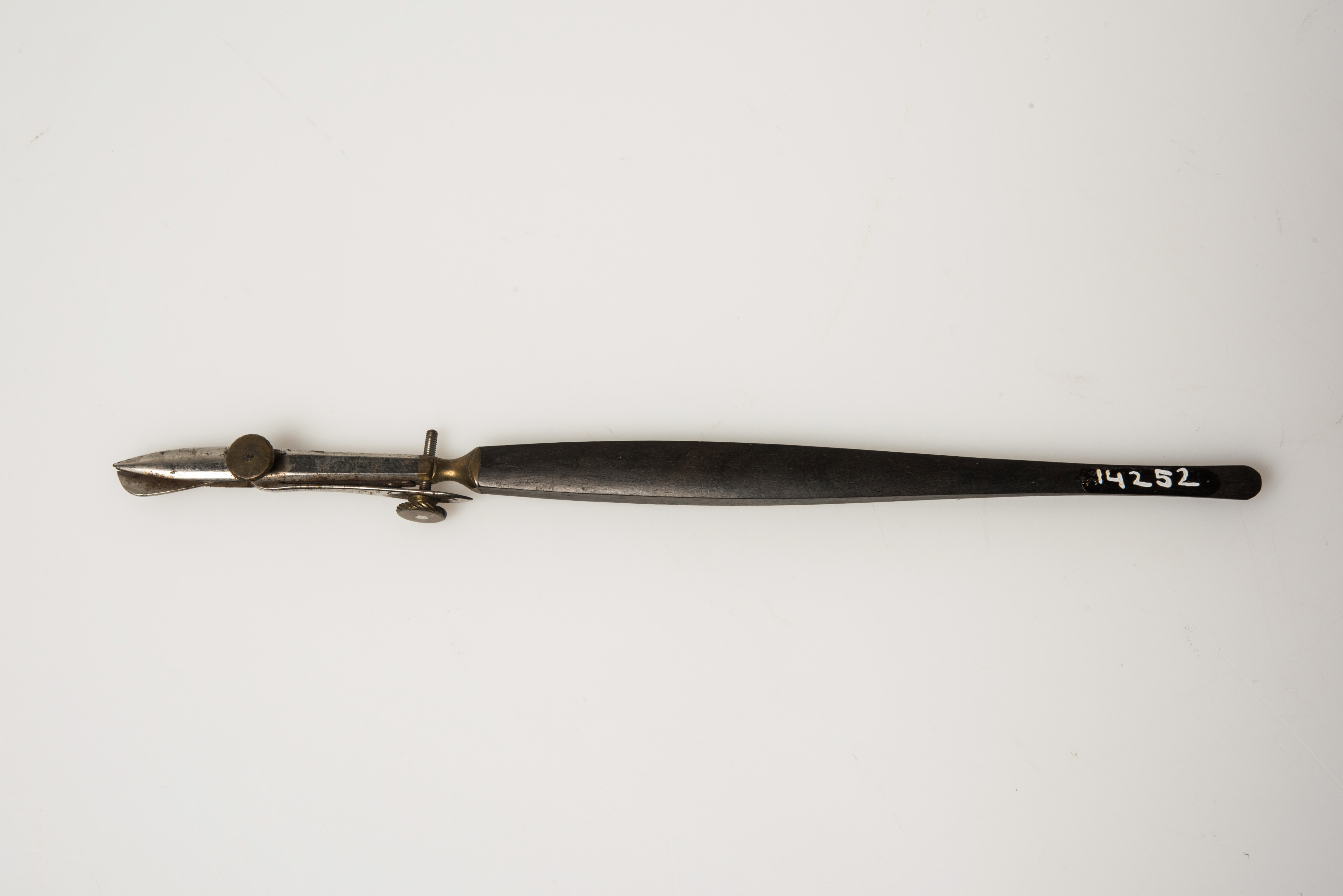
| INVENTORY NUMBER | 14252, MEDICAL COLLECTION OF THE UNIVERSITY ZURICH, INSTITUTE OF EVOLUTIONARY MEDICINE |
| AGE DETERMINATION | Mid-19th century |
| DESCRIPTION | The vaccination pen consists of a drawing pen with wooden handle. Between the beaks there is a fine lancet blade, which moves around the axis of the usual horizontal screw and can be released gradually by means of a second vertical screw. |
| COMMENT | The tear-spring construction of the tip is designed to prevent the inoculation incision from penetrating into the subcutis. However, this construction makes cleaning the knife more difficult. It was invented by the physician Eduard Wilhelm Güntz (1800-1880). As then secretary of the Medicinische Gesellschaft zu Leipzig, he made it public for the first time under the name «Impffeder» at the society's meeting on 24 June 1834. A few weeks later, a short section about the vaccination pen appeared in «Froriep, Ludwig Friedrich: Notizen aus dem Gebiete der Natur-und Heilkunde, gesammelt und mitgetheilt von Ludwig Friedrich v. Froriep. Ein und vierzigster Band, zwei und zwanzig Stücke (Nro. .881 bis 902), Landes-Industrie-Comptoirs, Weimar 1834, page 176», where the Leipzig instrument maker Moritz Hornn was mentioned as the manufacturer and source of supply. In 1835 the instrument was described in detail in an article in the «Jahrbüchern der in- und ausländischen gesammten Medicin, page 255» under the name «Impffeder des Dr. Güntz, adj. Stadtphysikus zu Leipzig»: «The vaccination pen resembles in the form a star knife and consists of a drawing pen with ebony handle, whose beaks wipe a fine lancet blade, which moves around the axis of the usual horizontal screw and is loosened by means of a second, in the proximity of the handle attached, vertical screw in any degree. The blade runs out at the cutting side into a so-called ripper. Its back cuts only at the upper convex ground end in the length of a line.». The earliest known illustration of the «Impffeder» comes from an encyclopedia of 1836 directed at the general public. On September 20, 1843, Güntz personally presented the device at the 21st meeting of German natural scientists and physicians in Graz following a lecture on a different topic, followed by a positive report by Dr. Fröhlich. In 1852 there was an other illustration in the book «Cessner, C. J.: Handbuch der chirurgischen Instrumenten- und Verbandlehre, L. W. Seidel, Wien 1852, page 90, Fig. 106» In the weekly «Berliner klinische Wochenschrift, No. 28, 13. Juli 1874» Dr. P. Loewenhardt wrote the following words about the vaccination pen according to Dr. Güntz: «The Günz'sche vaccination pen invented 1823 [...] can be obtained from the surgical instruments factory of Oswald Hornn, Leipzig, Universitäts- and Schillerstrassen-Ecke. It is strongly recommended that you order the small change I made to the spring and knife and also a spare knife (to avoid embarrassment).» It was not invented in 1823, as Loewenhardt wrote, but in 1834. 1823 is the founding year of the original manufacturer Moritz Hornn, whose business passed to Oswald Hornn in 1848. Since then the double name Güntz-Löwenhardt has sometimes been used. In the book «Pfeiffer Ludwig: Die Vaccination, ihre experimentellen und erfahrungsgemässen Grundlagen und ihre Technik, mit besonderer Berücksichtigung der animalen Vaccination. Verlag der H. Laupp'schen Buchhandlung, Tübingen 1884, pages 97 - 98, Fig. 6»Pfeiffer mentioned in addition to Güntz and Loewenhardt a Meinhardt: «Meinhardt and Güntze-Löwenhardt have installed special devices to prevent the knife from penetrating deeper than the epidermis [...]». |
| AUTORSHIP/INVENTOR | EDUARD WILHELM GÜNTZ (1800 - 1880)
SOURCES ABOUT GÜNTZ
|
| MANUFACTURER | Unknown |
Object 8: Vaccination certificate «Schutzblattern» (smallpox protection) for Frieda Knecht in Hinwil (ZH)
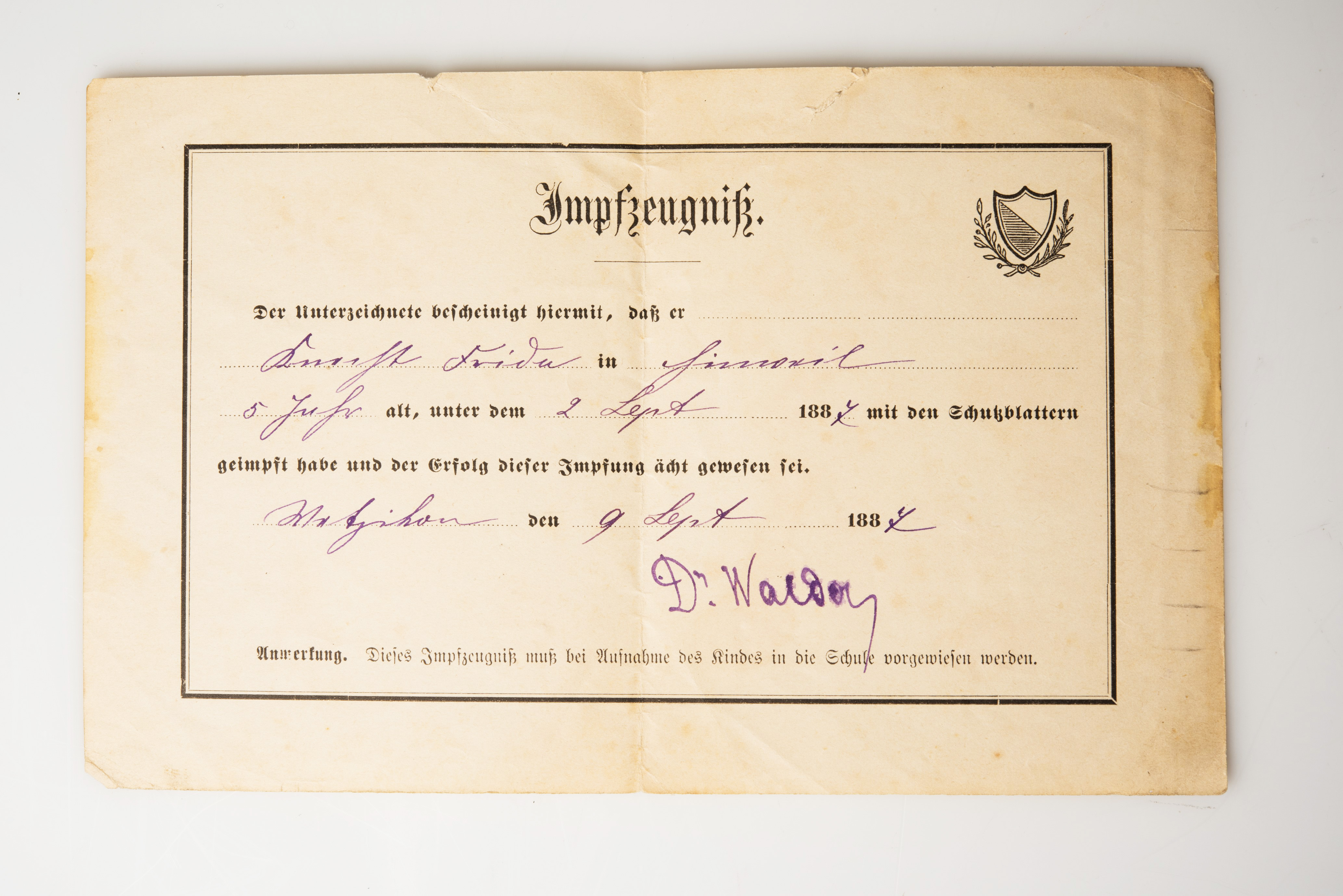
| INVENTORY NUMBER | 17094, MEDICAL COLLECTION OF THE UNIVERSITY ZURICH, INSTITUTE OF EVOLUTIONARY MEDICINE |
| AGE DETERMINATION | 1887 |
| DESCRIPTION | Vaccination certificate for protective smallpox from the canton of Zurich. Preprinted form with handwritten entries in ink: «Impfzeugnis. Der Unterzeichnete bescheinigt hiermit, dass er Knecht Frida in Hinwil 5 Jahr alt, unter dem 2 Sept 1887 mit den Schutzblattern geimpft habe und der Erfolg dieser Impfung ächt gewesen sei. Wetzikon den 9 Sept 1887 Dr. Walder Anmerkung. Dieses Impfzeugnis muss bei Aufnahme des Kindes in die Schule vorgewiesen werden.» (Vaccination certificate. The undersigned hereby certifies that he had vaccinated Knecht Frida in Hinwil 5 years old, under 2 Sept 1887 with the protective leaves and that the success of this vaccination had been outlawed. Wetzikon the 9 Sept 1887 Dr. Walder Note. This vaccination certificate must be presented when the child is admitted to school.). |
| COMMENT | As the note on the certificate states, the vaccination certificate had to be presented for admission to school. This «compulsory vaccination» was already then fought by opponents of vaccination, as the «Initiativebegehren betr. die Aufhebung des kantonalen Impfzwangs» from 20.11.1882 shows. In Switzerland, in 1882, the compulsory vaccination under the Epidemic Law was rejected by almost 80% of voters in the referendum. In 1883, the abolition of compulsory vaccination was enforced in various German-speaking Swiss cantons. The Epidemiengesetz (Epidemics Law) of 1886 (revised in 1970, total revision in 2013) continued to place the implementation of vaccination campaigns and the introduction of compulsory vaccination under the control of the cantons, the majority of which did not impose compulsory vaccination. The historian Matthias Steinmann describes in his essay «Impf-Alltag im 19. Jahrhundert. Das Verhältnis zwischen Ärzten und Bevölkerung vor dem Hintergrund der Pockenschutzimpfung im Kanton Luzern» that doctors were also negative about the vaccination business. It was labour-intensive and travel-intensive to go to the remote villages as a vaccinator. |
Object 9: Vaccination shield: To protect the pustules that develop after smallpox vaccination, which should serve as a source of new vaccine lymph
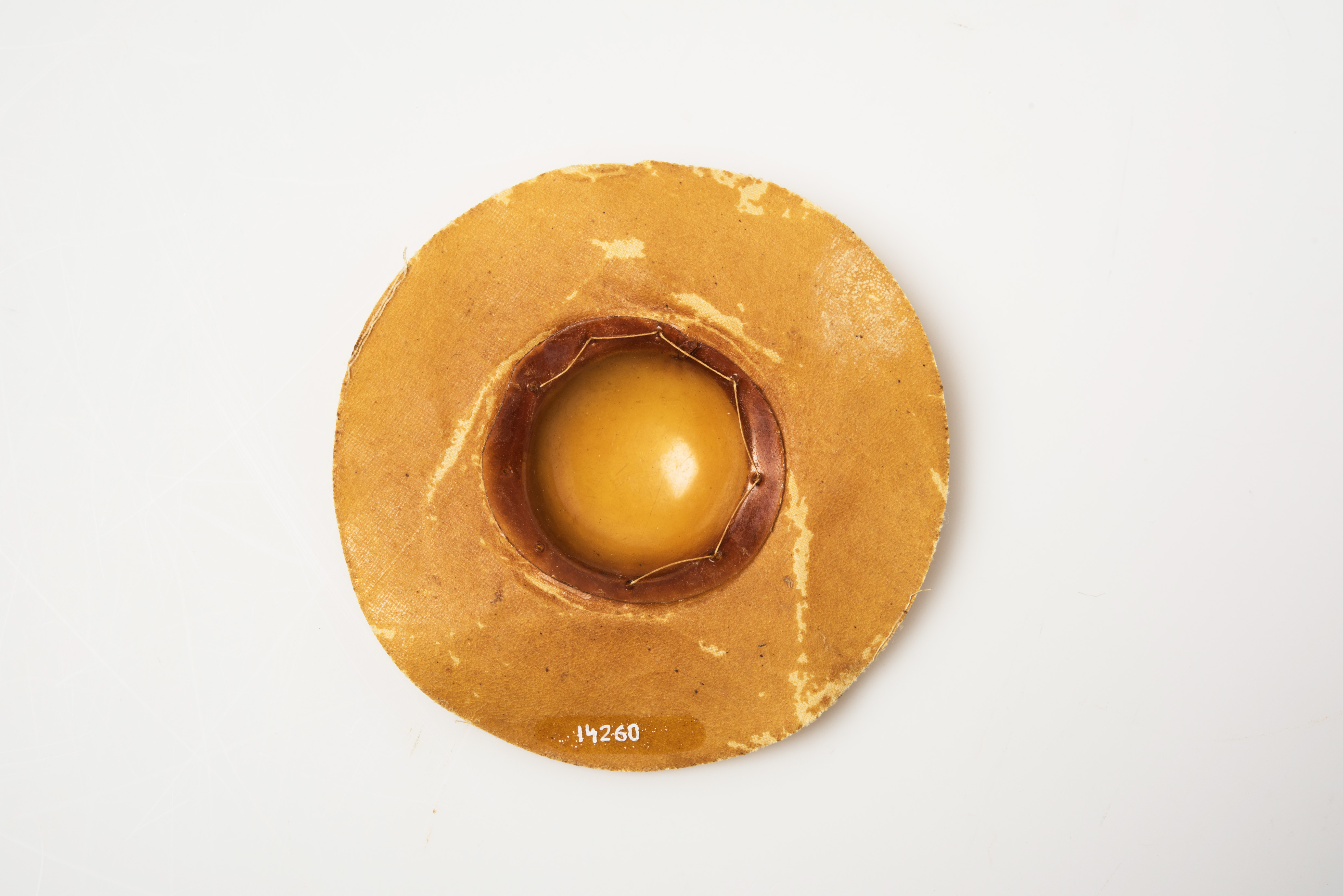
| INVENTORY NUMBER | 14260, MEDICAL COLLECTION OF THE UNIVERSITY ZURICH, INSTITUTE OF EVOLUTIONARY MEDICINE |
| AGE DETERMINATION | Late 19th century |
| DESCRIPTION | Ring-shaped piece of fabric, coated on one side. Inside a calotte of transparent material (celluloid). Used to protect the pustules that develop after smallpox vaccination (prevents removal by scratching or kicking), which should serve as a source of new vaccine lymph. |
| COMMENT | A Dr. August Seibert (Professor of Pediatrics, New York Polyclinic) presented in 1897 in the «New Yorker Medicinische Monatsschrift, pages 644 - 645» his new vaccination shield «Manhatten Vaccination Shield», which is compared to his predecessors (Vaccination shield made of wire mask, which is tied to the arm with ribbons. Vaccination shield made of an oval felt disc with a round opening in the middle, which is glued to the skin by means of gum arabic) in the characteristics «firm adhesion» as well as «sufficient protection for the vaccination site» was improved. |
| AUTORSHIP/INVENTOR | Unknown |
| MANUFACTURER | Unknown |
Object 10: Vaccination set from Goldschmidt
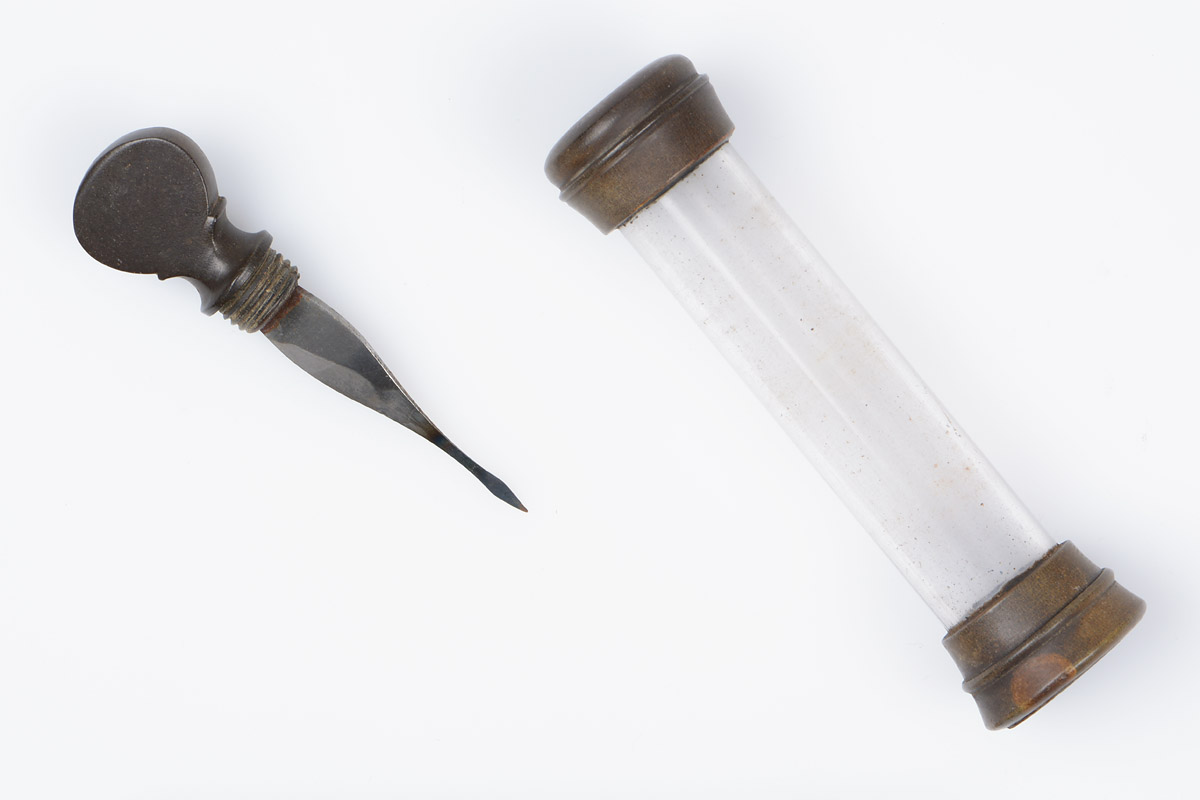
| INVENTORY NUMBER | 14264, MEDICAL COLLECTION OF THE UNIVERSITY ZURICH, INSTITUTE OF EVOLUTIONARY MEDICINE |
| AGE DETERMINATION | 1870 - 1880 |
| DESCRIPTION | Vaccination lancet with set-off, fine tip (blued from sterilisation in an open flame) and round handle with thread made of hard rubber. It can be screwed into a glass tube with brown hard rubber armouring with the tip facing the inside as a lid. The bottom of the tube consists of two glass plates, from which the outer one can be unscrewed. A large number of «Breton'sche Röhrchen» (Breton tubes for the preservation of the protective smallpox lymph) could be transported in the glass container, the contents of which were blown out onto the aforementioned glass plate if required. |
| COMMENT | Goldschmidt describes the device in the book «Systematische Zusammenstellung der Instrumente und Apparate für Medicin, Chirurgie, Geuirtskunde, Kriegsheilkunde, Hospitaldienst und Krankenpflege mit besonderer Berücksichtigung der Bandagen für Unterleibsbrüche und Orthopädie. Mit Abbildungen und Beschreibungen, page 21» with illustration and explanation. However, an inventor is not mentioned. It was probably invented by Goldschmidt or his people. |
| AUTORSHIP/INVENTOR | Possibly Goldschmidt (Compare MANUFACTURER). |
| MANUFACTURER | SAMUEL GOLDSCHMIDT (Also known as Siegmund Goldschmidt)
SOURCES ABOUT GOLDSCHMIDT
|
Object 11: Vaccination lancets with smallpox vaccine «Lancy-Vaxina» from the «Institut Vaccinal Suisse»
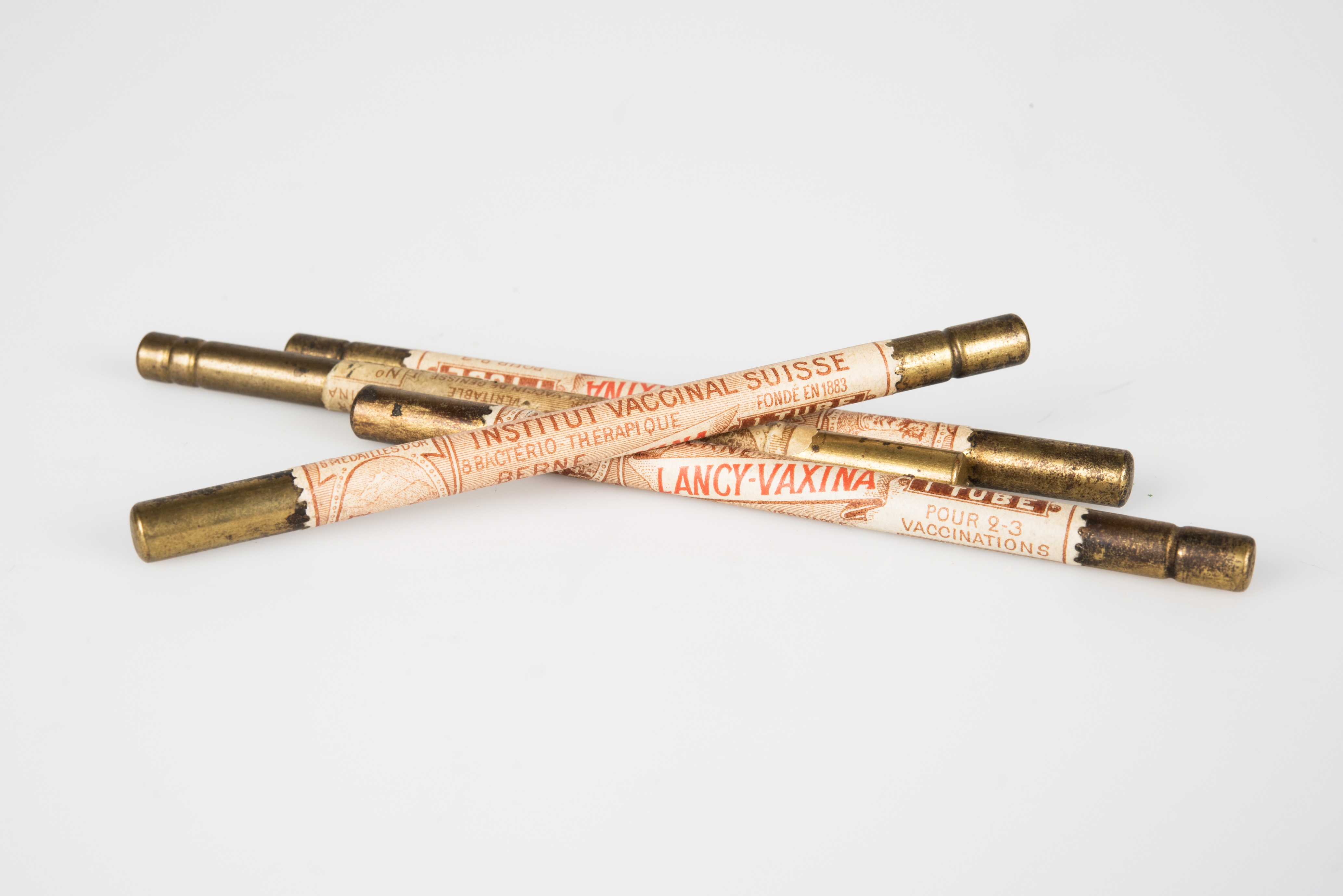
| INVENTORY NUMBER |
14267, MEDICAL COLLECTION OF THE UNIVERSITY ZURICH, INSTITUTE OF EVOLUTIONARY MEDICINE |
| AGE DETERMINATION | Around 1900 |
| DESCRIPTION |
4 vaccination lancets with smallpox vaccine "Lancy Vaxina" for 2 - 3 vaccinations. With tubular handle and aluminium cap. There's a label on the handle (one label per vaccination lancet).
On the label 1 and 2 the following is written: «6 MÉDAILLES D’OR», «MARQUE DÉPOSÉE», «INSTITUT VACCINAL SUISSE & BACTÉRIO-THERAPIEQUE BERNE», «FONDÉ EN 1883», «LANCY-VAXINA», «1 TUBE», «POUR 2-3 VACCINATIONS», «FOURNISSEUR DE L’ÉTAT», «VÉRITABLE VACCIN DE GÉNISSE», «No 2015». (6 gold medals, registered trademark, Institut Vaccinal Suisse & Bactério-therapieque Berne, founded 1883, Lancy-Vaxina, 1 small tube, for 2 to 3 vaccinations, Government supplier, real heifer vaccine, No 2015).
On the label 3 the following is written: «6 MÉDAILLES D’OR», «MARQUE DÉPOSÉE», «INSTITUT VACCINAL SUISSE & BACTÉRIO-THERAPIEQUE BERNE», «FONDÉ EN 1883», «LANCY-VAXINA», «1 TUBE», «POUR 2-3 VACCINATIONS», «FOURNISSEUR DE L’ÉTAT», «VÉRITABLE VACCIN DE GÉNISSE», «No 2261» (6 gold medals, registered trademark, Institut Vaccinal Suisse & Bactério-therapieque Berne, founded 1883, Lancy-Vaxina, 1 small tube, for 2 to 3 vaccinations, Government supplier, real heifer vaccine, No 2261).
On the label 4 the following is written: «7 MÉDAILLES D’OR», «MARQUE DÉPOSÉE», «INSTITUT VACCINAL SUISSE & SÉRO-THERAPIEQUE BERNE», «FONDÉ [1883]», «LANCY-VAXINA», «1 T[UBE]», «POUR [2-3] VACCINA[TIONS]», «FOURNISSEUR DE L’ÉTAT», «VÉRITABLE VACCIN DE GÉNISSE», «No 4[…]». (7 gold medals, registered trademark, Institut Vaccinal Suisse & Séro-therapieque Berne, founded 1883, Lancy-Vaxina, 1 small tube, for 2 to 3 vaccinations, Government supplier, real heifer vaccine, No 4...). |
| COMMENT |
On the advertising postcard shown above the vaccination lancet is illustrated. Below in the text the depots are listed, in which the vaccination lancets are stored and ready for the order stand. It is also interesting to mention that the Lancy-Vaxina implant chain has a 99-100% success rate for a first vaccination and a 70-80% success rate for a second vaccination. One vaccination lancet could be used for 2 to 3 vaccinations as it is written on the label. The great advantage of this vaccination lancet was that the vaccine was already integrated in a glass tube ready for use. The transport as well as the application was made much easier. The serum is merchandised from Bern under the name Lancy-Vaxina. |
| AUTORSHIP/INVENTOR |
INSTITUT VACCINAL SUISSE (FOUNDED 1883)
|
| MANUFACTURER | INSTITUT VACCINAL SUISSE (FOUNDED 1883) (see above) |
Object 12: Vaccination pen
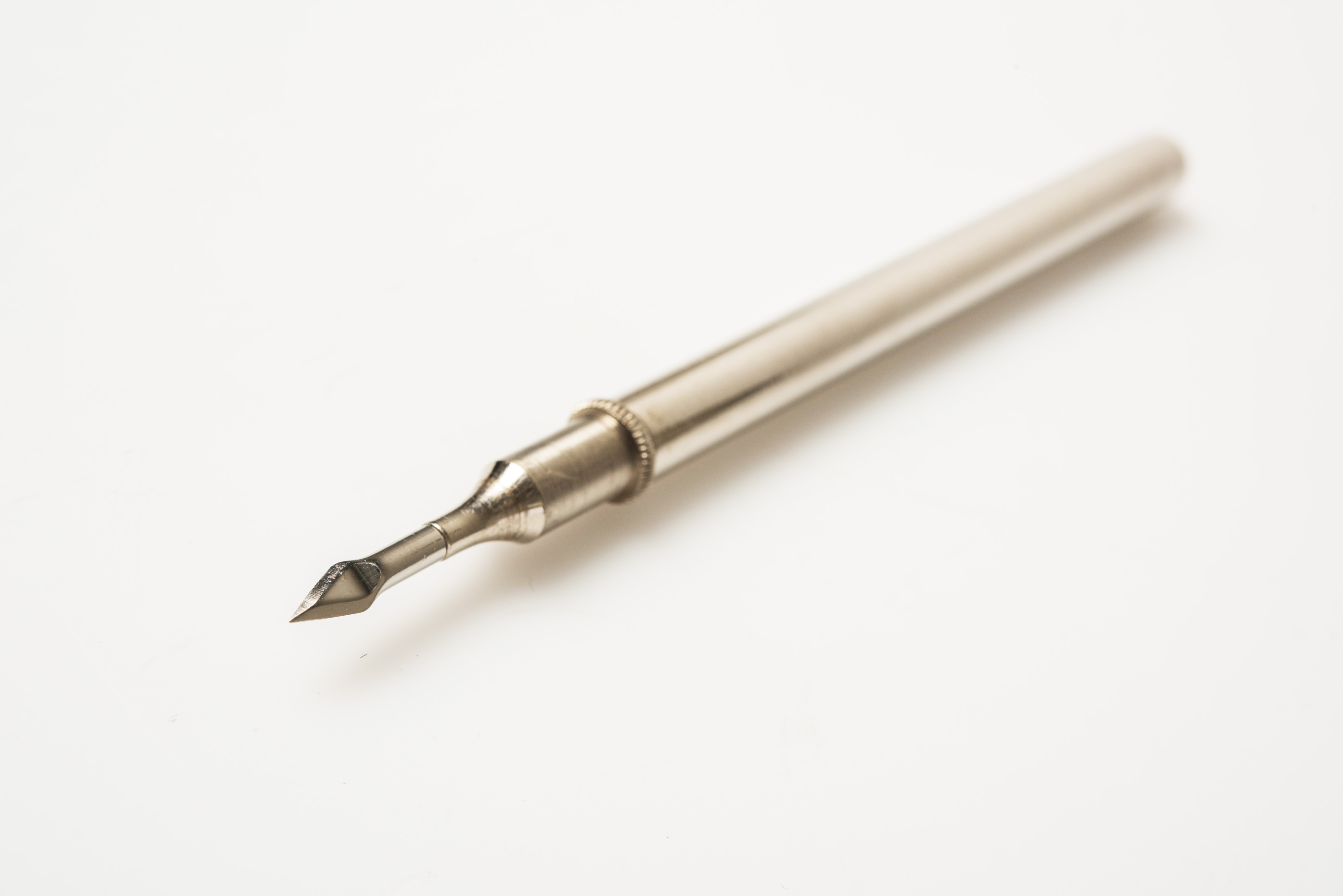
| INVENTORY NUMBER |
6044, MEDICAL COLLECTION OF THE UNIVERSITY ZURICH, INSTITUTE OF EVOLUTIONARY MEDICINE |
| AGE DETERMINATION | Mid-20th century |
| DESCRIPTION | Longitudinally round carrier, in which a lance-shaped double-edged knife / pen is inserted. |
| COMMENT | For safe transport, the knife / pen can be pulled off and turned upside down to be recessed into the handle, so that the metal sleeve is closed like a capsule. |
| AUTORSHIP/INVENTOR | Unknown |
| MANUFACTURER | Unknown |
Object 13: Vaccination lancet «Félix & Flück»
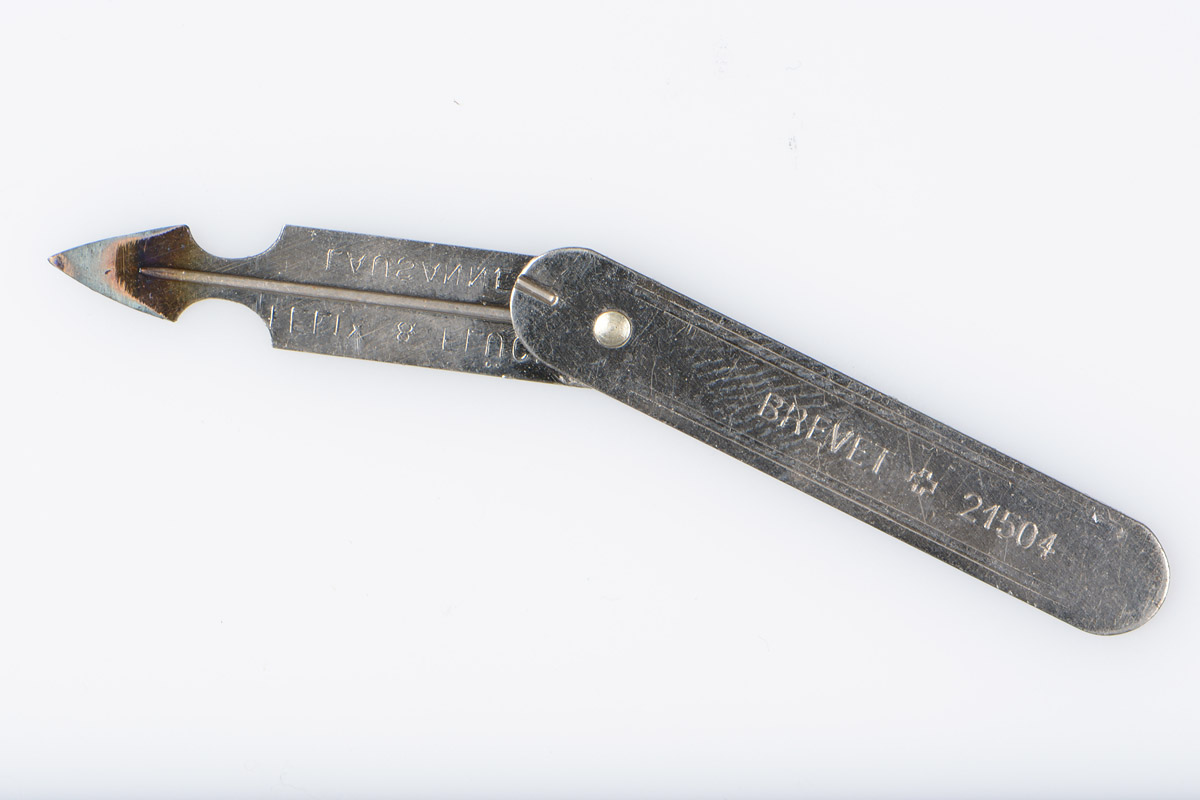
| INVENTORY NUMBER | 951, MEDICAL COLLECTION OF THE UNIVERSITY ZURICH, INSTITUTE OF EVOLUTIONARY MEDICINE |
| AGE DETERMINATION | 1901 |
| DESCRIPTION | The vaccination lancet consists of two parts, which are held together by means of a groove. This allows the implant chain to be folded together. The first part with the double-edged, lance-shaped knife is elongated in the middle and ribbed in a circular shape. The second part with the rounded end is ribbed at the sides and short ribbed in the middle above the round groove opening. There are two engravings under the blade:
|
| COMMENT | The patent specification with the number «Brevet 21504» was registered by the Federal Office of Intellectual Property on February 2, 1901. The elevations (ribs) on both parts of the implant chain lead to improved stabilization during application. The foldable blade made it possible to transport and store the vaccination lancet safely. The blade is discoloured from repeated sterilisation in the flame. |
| AUTORSHIP/INVENTOR & MANUFACTURER |
FÉLIX & FLÜCK, INSTITUT VACCINOGÈNE SUISSE, LAUSANNE
SOURCES ABOUT FÉLIX & FLÜCK
|
Object 14: Aseptic vaccination set in metal case
| INVENTORY NUMBER | 7023, MEDICAL COLLECTION OF THE UNIVERSITY ZURICH, INSTITUTE OF EVOLUTIONARY MEDICINE |
| AGE DETERMINATION | 20th century |
| DESCRIPTION | Long metal box with rounded corners and two lids. The case itself has three round holes at the bottom; in it there is an insert with a central channel (for lancet handle) and six rectangular holes at the top and at the bottom (for attachments for the lancets including insertable tips). In one row between the holes there is a letter of the word «STERIL» (Sterile) for the unused attachments. Six screw-on attachments for the lancet with insertable tips. 1 long, round lancet handle with integrated snap mechanism: at the end of the handle there is a rotating knob on the thread, which can be pulled up until the tip of the lancet has disappeared and then snaps into place; when the spring is pressed, the tip jumps out. On the middle of the lid is the Aesculapian logo (Aesculapian snake around a pole, crown). Above it is written «AESCULAP»: On the bottom right of the lid is written «ARNOLD BOTT». |
| COMMENT | It is an aseptic (germ-free) vaccination set, which consists completely of metal. The metal case can, for example, be filled with alcohol, then it is sealed airtight and the components of the vaccination kit inside are sterilized. The snap mechanism has a psychological advantage when it comes to anxious patients. The tip of the lancet is not visible when the lancet handle is placed on the skin and it only jumps out when the spring is pressed. In other words, patients (especially children) do not see the «dangerous and pointed» blade. |
| MANUFACTURER | AESCULAP AG
SOURCES ABOUT AESCULAP
|
| TRADE/DISTRIBUTION | ARNOLD BOTT, ZURICH
SOURCES ABOUT BOTT
|
